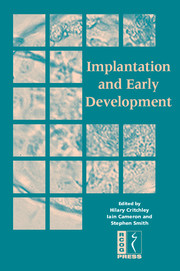Book contents
- Frontmatter
- Contents
- DECLARATION OF INTEREST
- Participants
- Preface
- SECTION 1 PREPARATION FOR IMPLANTATION – THE UTERINE ENVIRONMENT
- 1 Endocrine and paracrine signalling in the human endometrium: potential role for for the prostanoid family in implantation
- 2 Immunology of implantation
- 3 Progestin-indusced decidualisation promotes human endometrial haemostasis and vascular stabulity
- 4 Adhesion molecules and implantation
- 5 Vascular growth and modelling in the endometrium
- 6 Tissue remodelling the fetal-maternal interface: the regulation of matrix metalloproteinase 9 transcription
- 7 Embryo interactions in human implantation
- 8 Experimental models of implantation of the human embryo: reconstructing the endometrial–embryo dialogue in vitro
- SECTION 2 THE EMBRYO
- SECTION 3 LESSONS FROM ANIMAL MODELS (TRANSGENICS) AND NOVEL TECHNOLOGIES
- SECTION 4 CLINICAL SEQUELAE
- SECTION 5 CONSENSUS VIEWS
- Index
8 - Experimental models of implantation of the human embryo: reconstructing the endometrial–embryo dialogue in vitro
from SECTION 1 - PREPARATION FOR IMPLANTATION – THE UTERINE ENVIRONMENT
Published online by Cambridge University Press: 05 June 2014
- Frontmatter
- Contents
- DECLARATION OF INTEREST
- Participants
- Preface
- SECTION 1 PREPARATION FOR IMPLANTATION – THE UTERINE ENVIRONMENT
- 1 Endocrine and paracrine signalling in the human endometrium: potential role for for the prostanoid family in implantation
- 2 Immunology of implantation
- 3 Progestin-indusced decidualisation promotes human endometrial haemostasis and vascular stabulity
- 4 Adhesion molecules and implantation
- 5 Vascular growth and modelling in the endometrium
- 6 Tissue remodelling the fetal-maternal interface: the regulation of matrix metalloproteinase 9 transcription
- 7 Embryo interactions in human implantation
- 8 Experimental models of implantation of the human embryo: reconstructing the endometrial–embryo dialogue in vitro
- SECTION 2 THE EMBRYO
- SECTION 3 LESSONS FROM ANIMAL MODELS (TRANSGENICS) AND NOVEL TECHNOLOGIES
- SECTION 4 CLINICAL SEQUELAE
- SECTION 5 CONSENSUS VIEWS
- Index
Summary
Implantation failure: a major challenge in in vitro fertilisation
Failure of the embryo to implant successfully into the endometrium is one of the major causes of infertility. Many causes of infertility, such as sperm dysfunction and certain disorders of the fallopian tube or ovary, can now be identified and either treated or bypassed by in vitro fertilisation (IVF). However, up to 20% of cases of infertility have no apparent cause and are labelled ‘unexplained’, and for which there is no treatment other than IVF. Approximately one-third of normal human pregnancies end in miscarriage and 22% of these occur before pregnancy is detected clinically, probably as a result of failure of the embryo to implant properly. The frequent failure of IVF treatment, despite the repeated replacement of apparently high-quality embryos, demonstrates that a woman's fertility ultimately depends on the ability of the embryos to implant successfully into the endometrium.
The successful establishment of a pregnancy is also influenced by other factors in addition to endometrial receptivity and morphological quality of the embryo, and the failure of the embryo to implant may also result from impairment of the genetic potential of the embryo, which remains an intractable problem. The pregnancy rates from donated oocytes in older women (> 40 years) are similar to those of younger women in egg-donation IVF cycles, and in both groups the majority of embryos fail to implant and establish a pregnancy.
Keywords
- Type
- Chapter
- Information
- Implantation and Early Development , pp. 90 - 100Publisher: Cambridge University PressPrint publication year: 2005

